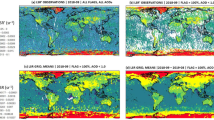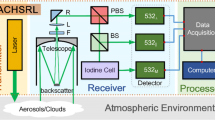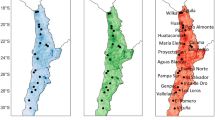Summary
Polar-orbiting NOAA14 AVHRR (Advanced Very-High-Resolution Radiometer) based estimates of surface reflectance, with a spatial resolution of about 1.1 km at nadir, were derived for a single almost cloud-free image of snow-covered, partly-forested boreal terrain in northern Finland. As a part of the WINTEX campaign, comparative measurements of reflectance were made along three 30 km flight legs with downward and upward-facing broadband pyranometers installed in a C-130 aircraft. After co-location of the satellite sensor pixels and the airborne samples, the two estimates of broadband (0.3–3 μm) surface reflectance matched to within 2%, with a standard error of 4.4% (absolute units). The reflectance variation obtained by the aircraft along the flight legs was well matched by the satellite-based method.
A method was developed for generating a parametrized regional distribution of surface reflectance by assigning random reflectance values to the main land-cover categories. These random values, for the three land-use classes: ‘open’, ‘transitional’ and ‘forest’, were drawn from the approximated normal distribution of reflectances based on the measurements from an aircraft flying at a height of 80 m above the surface. The reflectance distribution for the 100 km × 100 km region thus obtained using the land-cover data set was quite similar to the corresponding satellite-based distribution for the winter day-time snow-covered terrain analysed here. During winter, however, frequent changes in reflectance distributions are to be expected due to the variation of snow interception on trees and snow ageing. It is thus suggested that the parametrized distributions of surface reflectance should be complemented with real-time satellite-based estimates to account for the daily variation of surface reflectance, particularly when the snow cover is changing rapidly.
Similar content being viewed by others
Author information
Authors and Affiliations
Additional information
Received November 22, 1999 Revised July 20, 2000
Rights and permissions
About this article
Cite this article
Kangas, M., Heikinheimo, M. & Laine, V. Accuracy of NOAA AVHRR-based surface reflectance overa winter-time boreal surface – comparison with aircraft measurements and land-cover information. Theor Appl Climatol 70, 231–244 (2001). https://doi.org/10.1007/s007040170017
Issue Date:
DOI: https://doi.org/10.1007/s007040170017




